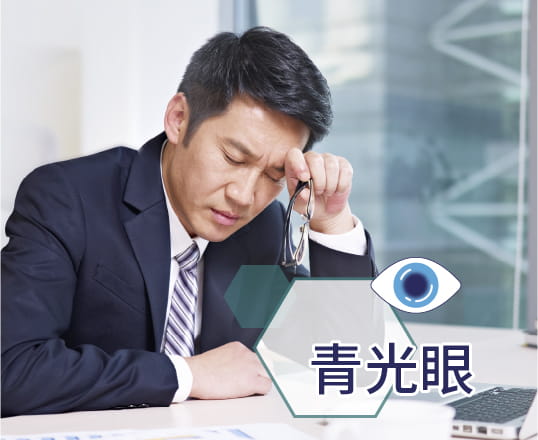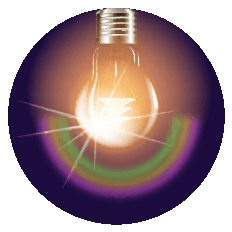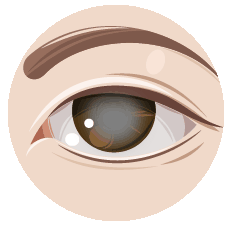


Glaucoma
你曾聽過青光眼是「視力小偷」嗎?因為部份青光眼令視力喪失前,你都不會察覺得到它的存在,沒有任何疼痛或症狀產生,患上後亦不能恢復。青光眼成因包括 :深度近視/遠視、睡眠窒息症、長期偏頭痛等,若有這些成因需定期進行眼睛檢查,一旦發現青光眼,需立即尋找眼科醫生的調理建議。及早發現眼疾及調理,減低視力受損的機率。
What is Glaucoma?
青光眼通常是指眼球壓力過高而造成眼後房視網膜及視神經上纖維逐漸損壞,不過亦有患者的眼壓處於正常範圍(10-21mmHg),但視神經仍承受不了壓力而受損,引致視野缺失。患者早期的視野慢慢由周邊視力損失開始至剩下中央部份。若沒有適當調理,視力減退甚至完全失明。青光眼無明顯徵狀,一般難以察覺,發現嘅時候視野收窄,傷害不可逆。女性患上急性青光眼的風險較高,尤其是步入中年及以上的女性;然而,即使是兒童,一樣可以患上青光眼。

Types of Glaucoma
Chronic Glaucoma

Acute Glaucoma

Primary and Secondary Glaucoma
Glaucoma

Causes of Glaucoma

Aged 40 or above
Aging plays an important role in glaucoma, as its prevalence increases exponentially with age. However, the pathophysiology of increasing age as a risk factor for glaucoma is unclear.

Family inheritance
While everyone can develop glaucoma, you may be at higher risk if glaucoma runs in your family. The most common form of glaucoma, open-angle glaucoma, is hereditary. If you have an immediate family member with glaucoma, your risk of developing the disease is 4 to 9 times higher.

History of eye injury
(especially blunt trauma)
If the eyeball is unfortunately hit head-on by a fast-moving hard object, it may cause bleeding of the iris and other structures, block the flow of aqueous humor, and cause an increase in intraocular pressure. With proper treatment, the optic nerve can be protected from permanent damage. However, if the structure near the ciliary body or trabeculae is damaged due to impact, it may affect the drainage system, causing long-term increase in intraocular pressure and inducing glaucoma.

High myopia/hyperopia
In addition to people with hyperopia who are prone to corner-angle closed glaucoma, high myopia is also one of the causes of chronic open-angle glaucoma. Studies have also pointed out that myopic eyes are more susceptible to increased intraocular pressure; if myopia of more than 400 degrees is accompanied by increased intraocular pressure, it is more likely to cause visual field defects.

Diabetes
The relationship between diabetes and open-angle glaucoma, the most common type of glaucoma, has intrigued researchers for years. People with diabetes are twice as likely to develop glaucoma as people without diabetes.

Sleep Apnoea
In recent years, literature research has pointed out that sleep apnea is related to glaucoma. It is possible that the patient's body is deprived of oxygen during sleep, which affects the blood circulation around the eyeballs, deprives the optic nerve of oxygen, and slowly degrades vision.

Chronic migraine
青光眼一般分為急性和慢性,其中導致明顯的偏頭痛多為急性青光眼。由於眼球前房的出口孔道在短時間內閉塞,導致眼壓急速上升,更常會有角膜水腫,引發劇烈頭痛,所以就很容易被誤認為偏頭痛而延誤調理。

Cardiovascular disease
High blood lipids may also cause glaucoma. Although it does not directly cause eye disease, research statistics show that it does cause an increase in intraocular pressure, thereby increasing the risk of glaucoma.

Hypertension
Studies have found that patients with high blood pressure are twice as likely to suffer from "normal intraocular pressure glaucoma" as other people. This is because high blood pressure can damage the blood circulation regulation system of the eyeball and cause blood flow in the eyeball to be disordered. Therefore, although the intraocular pressure is normal, it will accelerate the withering of the optic nerve.

Increased eye pressure
due to steroid use
Steroid glaucoma is one of the sequelae of long-term use of steroids and is also considered a type of open corner glaucoma. Long-term use of steroids may cause the aqueous humor drainage hole of the eyeball to be blocked, resulting in a decrease in the drainage rate of aqueous humor and an increase in intraocular pressure. However, as long as the use of steroids is stopped, the intraocular pressure of most patients can drop to the normal range.
Symptoms of Glaucoma

No obvious sign and symptom in the early stage. Over time, the peripheral vision shrinks and the patient loses central vision.

Eye redness, seeing rainbow circles around lights, vision loss, eye pain, headache and vomiting, etc.
青光眼調理方法

據統計,全香港約有12萬名青光眼患者,當中40歲以上有5%人患有青光眼。目前青光眼是無法補回已失去的視力,但只要及早進行青光眼檢查 (檢視眼壓、角膜等健康情況) 和診斷,加以適當調理,仍可以避免或減慢視力流失。
| 療程方案 | 療程方法原理 | Degree of illness |
|---|---|---|
| Eye Drops | 患病初期可用藥物(眼藥水)控制病情,可以保護及保持患者的視神經組織及其功能,控制眼壓水平至合適的目標範圍之內,減少視神經進一步的損害,並以把視力功能穩定下來為主要目的。相對其他療程方案,眼藥水會產生嚴重的副作用較少,亦比手術及激光療程較為安全。 | 初期調理 |
| Laser trabeculoplasty | By creating small holes around the iris, the flow of aqueous humor is promoted to reduce intraocular pressure. | 開角型青光眼 (初期調理) |
| Peripheral iridectomy | Laser is used to stimulate the drainage structure in the eye, increase fluid drainage, and help reduce intraocular pressure. | 開角型青光眼 (中期調理) |
| Selective laser trabeculoplasty | Lasers are used to repair specific mesh structures to promote drainage and reduce intraocular pressure. | 開角型青光眼 (中期調理) |
| Micropulse light cyclophotocoagulation | Micropulse light is used to irradiate the ciliary body tissue to reduce the production of aqueous humor to reduce intraocular pressure. | Patients with refractory glaucoma or those who require further intraocular pressure control |
Caution
Prolonged use of eye drops may cause dryness and redness in the eyes and may even cause allergy and discomfort.
Glaucoma FAQ
Does it have to be high eye pressure to have glaucoma?
No, there is a type of glaucoma called low-tension glaucoma, where the eye pressure is below 21mmHg (glaucoma is generally suspected when the eye pressure is above 21mmHg).
Could headache be caused by glaucoma?
頭痛的原因可以有很多種,但原來有很多都是同「頭部」無關,反而是跟眼睛有關,稱之為「眼源性頭痛」,其中一種常見情況就是急性青光眼。由於眼球前房的出口孔道於短時間內閉塞,導致眼壓急速上升,更常會有角膜水腫,最終引發劇烈頭痛,但就容易被誤認為偏頭痛。如延誤調理。有機會損害視覺神經,甚至令病患急速失去視力,所以如果持續發生頭痛、眼睛疼痛、按壓眼球時頭痛加劇、視力模糊、噁心的症狀,就應盡快找眼科醫生求助。
How to detect early-stage glaucoma?
Because early-stage glaucoma has no obvious symptoms, it steals vision silently at any time. When you find that your field of vision is narrowed, irreversible damage has been done to your eyes. Therefore, it is recommended that adults undergo regular comprehensive eye examinations every one to two years to check intraocular pressure, cornea and other eye health conditions to avoid missing opportunities to control the disease.

